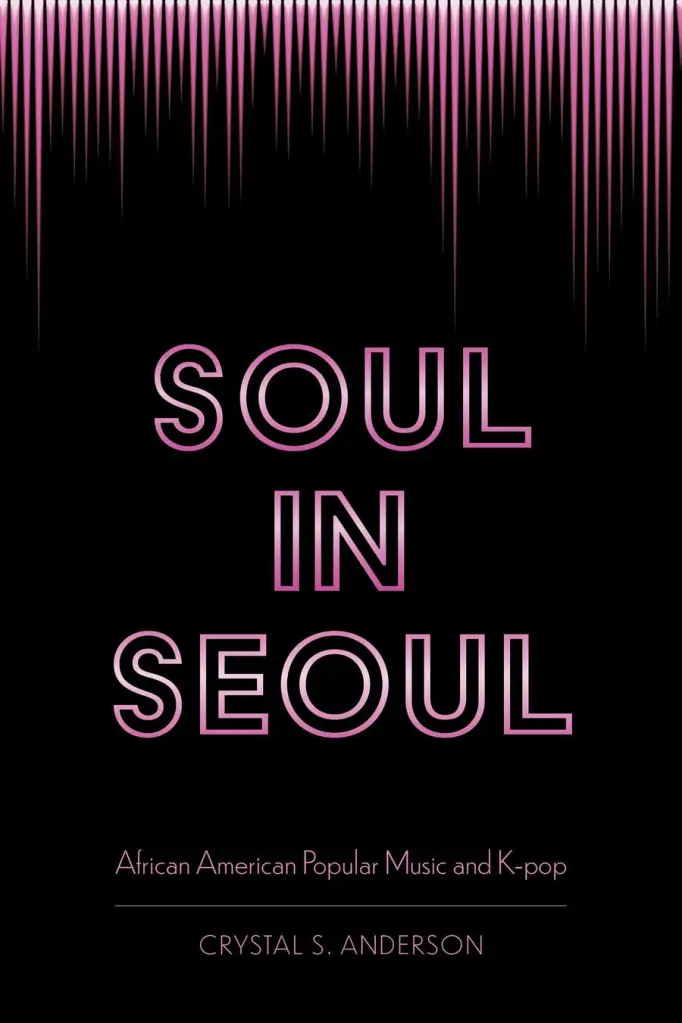Popular music definitely benefits from a focus in individual artists and groups, but often times music documentaries unnecessarily depict their fans as monolithic.
Continue reading “The Myth of Pop Music Silos”Soul in Seoul: African American Popular Music and K-pop
Soul in Seoul: African American Popular Music and K-pop is the first scholarly book to examine how contemporary Korean popular music (K-pop) references and incorporate musical and performative elements of various genres of African American popular music. Specifically, it argues that K-pop simultaneously cites instrumentation and vocals from various genres of black popular music and employs distinct Korean musical strategies, thereby enhancing the R&B music tradition. Such citational strategies are deemed authentic by global fan critics who function as part of K-pop’s music press. Defining K-pop as an umbrella rather than a genre, the book explores music by Korean pop (commonly referred to as “idols”), R&B and hip-hop solo artists and groups to reveal how K-pop functions as a global branch in a global tradition of R&B music.
Listen to the Soul in Seoul Spofity Playlist!
Soul in Seoul YouTube Playlist
BOOK TALK: Soul in Seoul: African American Music and K-pop @ CSU-Dominguez Hills
Looking for something exciting to do during the pandemic? Check out this book talk at 1:00 – 2:30 (PST) on April 30, (sponsored by the Department of Interdisciplinary Studies and Africana Studies at California State University, Dominguez Hills). Register here.

K-pop as Popular Music
K-pop is a form of popular music whose significance goes beyond its financial success.
In January 2021, Esquire published Emma Carey‘s article, “The Best Pop Bands of All Time Prove the Universal Power of Music,” which acknowledged the slippery nature of the label of “pop,” but also declared: “In simple terms, pop music is literally. . . popular music.” It goes on to explain the criteria for the listing of best pop bands: “When it comes to pop bands, we’re basically just looking at collectives of hit-makers, no matter their pop purity or crossover creed. From rock and roll adjacent pop bands like The Beatles, to Motown greats like The Supremes, R&B/pop/ crossovers like Destiny’s Child, and disco-influenced pop acts like ABBA, the variety of pop bands knows no bounds. The only requisite to making the cut? Topping the charts.” The article lists only one K-pop group, BTS, a choice that conforms to list’s criteria. For Esquire’s list, economic success equals chart success and chart success equals popularity.
But should chart success define popular music? Elijah Wald, author of How the Beatles Destroyed Rock ‘n’ Roll: An Alternative History of American Popular Music, reminds us of the original function of music charts: “It is always worth remembering that they were intended specifically to serve the needs of the record and radio industries, and at best measured only selected markets. The charts of pop, R&B, and C&W hits were never meant to be lists of people’s favorite performers or songs; they were lists of favorite–or most-played, or best-selling–singles” (181). Wald reminds us that the whole concept of charts serves the music industry rather than audiences. Currently, charts like Billboard use a method that includes paid digital downloads and digital streams. Both indicate economic impact, or how well an act sells.
K-pop’s audiences are spread across ages, locations and, most importantly, greatly vary in their ability to contribute to the economic criteria for the charts. There are many K-pop fans who may not have access to paid digital downloads, streaming plays and streaming data or may not engage with them frequently. Using these metrics do not capture how these fans feel about their artists. Moreover, it is widely known that K-pop fans work to collectively mass stream their favorite artists to improve their performance on these metrics, so that such metrics do not always reflect an organic popularity. When we define popular music by economic success, we marginalize and erase significant figures from the landscape of K-pop, which skews our perception of K-pop as a music tradition spanning over 20 years.
It might help to view K-pop as popular music defined beyond economic success. In Understanding Popular Music, Roy Shuker warns against using commercial success as a basis for a definition of popular music: “Related to this emphasis on the popular, are definitions emphasizing the commercial nature of popular music and embracing genres perceived as commercial, with the term ‘mainstream’ often used to indicate these. . . . In such definitions, certain genres are identified as ‘popular music,’ while others are excluded. However, this approach can suffer from the same problems as those stressing popularity because many genres have only limited appeal or have had limited commercial exposure. Moreover, popularity varies from country to country and even from region to region within national markets” (5).
Defining popular music solely by its financial success marginalizes and excludes. Shuker suggests that music can be popular without widespread financial success: “The criteria for what counts as popular, and their application to specific musical styles and genres, are open to considerable debate. Classical music clearly has sufficient following to be considered popular, while some forms of popular music are quite exclusive (e.g. Norwegian black metal)” (5). K-pop is like Norwegian black metal in that it appeals to a subculture not in the mainstream but it is still popular music. Wald is concerned with avoiding reductive canons that can emerge when we solely focus on popularity defined by economic success: “One thing I want to stress is that I am trying to write history, not criticism–that is, to look at some of the most influential movements and stars of the twentieth century and explore what links and divides them without worrying about whether they were marvelous or pernicious, geniuses or frauds, or whether I personally enjoy their work” (10). In other words, Wald seeks to look at the context that surrounds popular music rather than assume that the best-selling are the only significant figures. Considering K-pop as popular music would mean going beyond the best-selling artist to explore the musical environment of the time.
Sources
Emma Carey. “The Best Pop Bands of All Time Prove the Universal Power of Music.” Esquire. 30 Jan 2021. https://www.esquire.com/entertainment/music/g35279080/best-pop-bands/ (2 Mar 2021).
Elijah Wald. How the Beatles Destroyed Rock ‘n’ Roll: An Alternative History of American Popular Music. Oxford University Press, 2011.
Roy Shuker. Understanding Popular Music. Routledge, 2016.

K-pop as Popular Music by Crystal S. Anderson is licensed under a Creative Commons Attribution-NonCommercial 4.0 International License.
Writing about K-pop: Choose Your Disciplinary Adventure

In my previous article, I talked about how taking a historian’s approach to K-pop considers the past in making sense of the present. In this article, I’ll discuss how this informs my approach to K-pop in my book Soul in Seoul: African American Popular Music and K-pop. In making sense of K-pop, I choose several disciplinary approaches to increase our understanding of K-pop music.
The first thing scholars do when writing about a subject is to think about how the study will contribute to what we already know, or as we call it, the body of knowledge. Much of the scholarship on K-pop focuses on factors around K-pop music, but very little of it focuses on the music itself. From my previous research, I knew that music was the primary appeal of K-pop to global fans. As a fan who listens to a broad array of K-pop, I also know (like many others) that it incorporates influences from African American popular music. But what does that mean? This becomes my inquiry, or research question.
Scholars usually write about things using the tools and methods of an academic discipline. Different academic disciplines ask different questions. They can come to different conclusions, even while considering the same thing. Those methods are tools and some tools work better for certain jobs. The same goes for using disciplinary methods to explore a research topic. In order to answer my question, I choose to to use use multiple tools by using a multidisciplinary approach that includes popular music studies, transnational American Studies and fan studies.
Popular music studies seems like a no-brainer. K-pop and African American popular musics are popular musics. However, as a tool, popular music studies allows me to consider both the music and its audience as well as the way the audience experiences the music. Global fans enjoy K-pop without necessarily knowing the lyrics, just as Korean artists incorporated African American popular music without knowing the lyrics. This is because music itself has meaning that speaks to emotion and transcends language. Popular music studies helps to reveal the music’s meaning.
Transnational American studies allows me to view the way African American popular culture travels and influences other cultures. It has a complicated relationship to the larger American culture, which has sometimes been used as part of a cultural imperialist project when it has traversed the globe. African American culture is, in part, shaped by the larger American values. At the same time, it challenges aspects of that larger culture. So we have to see African American popular culture with complexities rather than as a part of a monolithic “Western culture” or ambassador of American culture to the world. It carries the distinct experiences and aesthetics of African Americans. In order to understand the hybridity of K-pop, I draw on the well-developed field of African American cultural studies to illuminate the meaning of those aesthetics, which go beyond oppression and discrimination.
Both popular music studies and transnational American studies value knowledge outside of traditional academia. Both disciplines treat non-academics as valued knowledge producers, including music journalists and critics and amateur historians and archivists. They tend to focus on topics that have yet to be recognized by the mainstream, but are nevertheless significant. As a result, I use fan studies to elucidate the role of the fan reviewer of K-pop. These fans act as creators and archivers of information about K-pop, including music reviews. Examining these reviews gives me a sense of how the audience for K-pop makes sense of the music.
Thus, popular music studies, transnational American studies and fan studies act as a Swiss army knife that I use to make sense of K-pop music and contribute to our understanding of it.
Soul in Seoul: African American Popular Music and K-pop (2020, University of Mississippi Press) explores how K-pop draws on various genres of black popular music and how fans deem such practices as authentic. It is available at Amazon, Barnes and Noble, and University of Mississippi Press.

Writing about K-pop: Choose Your Disciplinary Adventure by Crystal S. Anderson is licensed under a Creative Commons Attribution-NonCommercial 4.0 International License.
Writing About K-pop: History and Context

One of the first things I wanted to do with my book, Soul in Seoul: African American Popular Music and K-pop, is to recognize K-pop’s history and development. Placing K-pop within a historical context is crucial to the way we ultimately understand it.
K-pop is often seen in present-day terms. It is described and treated as a short-term trend. Much of what many people know about K-pop comes through the media. Journalists tend to focus on the current developments and their coverage of K-pop is no exception. K-pop’s coverage includes metrics of popularity, such as views, streams, charts and awards. We need that coverage.
At the same time, Elijah Wald sees a difference between the way critics and historians approach popular music in his introduction to How the Beatles Destroyed Rock ‘n’ Roll: An Alternative History of American Popular Music (2011):
The critic’s job is to assign value and importance on an artistic level, which necessarily is a judgment about how the work stands up in the present. The historian’s is to sort out and explain what happened in the past, which means attempting to understand the tastes and environment of an earlier time. And the latter task also involves sorting out and understanding how earlier critics and historians were affected by their own times. (8).
My book, in part, tries to understand K-pop, beginning with what it actually is. As early as 2013, I explored how we could talk about K-pop in a way that recognized its highly visible pop groups (i.e. “idols”) but also included other types of groups that K-pop fans also liked, thereby avoiding the often-repeated myth that K-pop is a genre (“Let’s Call This Song Exactly What It Is: Defining K-pop” 2013).
Understanding K-pop also involves recognizing K-pop’s iterations and developments over time, which is much more like a historian than a critic. In addition to talking about the way black popular music informed K-pop, I felt that it was also important to talk about K-pop examples and explain why these examples were important within the larger historical narrative of K-pop. For example, each section of the book begins with a bit of contextualization, explaining where the groups under discussion fit in the general history of K-pop and how they relate to each other.
For example, g.o.d, a first-generation K-pop group, and 2PM, a second-generation K-pop group, were both labelmates at JYP Entertainment and their sound draws from black popular music. While the prevailing notion is that all “idol” groups sound the same, these groups couldn’t be more different in terms of genres of black popular music they draw from and the way they use their vocalists to produce very different music. Only by understanding them in relation to each other can see how they are related as well as their differences. Ultimately, I emulate Wald’s attempts “to write history, not criticism–that is, . . . [to] explore what links and divides them without worrying about whether they were marvelous or pernicious, geniuses or frauds, or whether I personally enjoy their work” (10). Like Wald, I’m more interested in connections among artists across time.
K-pop warrants a consideration of its history because it impacts the way we see it now.
Soul in Seoul: African American Popular Music and K-pop (2020, University of Mississippi Press) explores how K-pop draws on various genres of black popular music and how fans deem such practices as authentic. It is available at Amazon, Barnes and Noble, and University of Mississippi Press.
Sources
Wald, Elijah. How the Beatles Destroyed Rock ‘n’ Roll: An Alternative History of American Popular Music. Cary: Oxford University Press, 2011.

Writing About K-pop: History and Context by Crystal S. Anderson is licensed under a Creative Commons Attribution-NonCommercial 4.0 International License.
What K-pop Can Teach Us About Engagement for Online Courses

One of the most common concerns about moving courses online is that engagement is lost. However, it could be useful to draw on the kind of engagement that is central to contemporary Korean popular music (K-pop) culture.
Most articles you may read about the need to teach online courses (as opposed to the emergency remote teaching that most instructors engaged in in the spring) contains the often unchallenged assertion that online courses cannot replicate the engagement of the face-to-face course, seen by many as indispensable to learning. John Kroger recently wrote in Inside Higher Education: “In the process, we have gained a much clearer understanding of what online education cannot do — or, in other words, the ways in which traditional in-person cannot be replaced. The most obvious area in which online delivery simply cannot replicate the value of in-person learning is in science and technology education. ” For many, this extends to other disciplines as well. Many people believe that being face-to-face is essential to learning. Period. Related to this critique is the characterization of online courses. Drawing on their experience this past spring or bad online course experiences, some argue that online courses are merely videos and quizzes.
We know that learning is a social activity. Instead of trying to replicate the face-to-face experience, we might look to modes of engagement that already work online. K-pop artists and fans have used the digital space to form connections and have engaging and memorable interaction for years. K-pop artists use social media such as Twitter, Instagram, VLive and YouTube to communicate with fans and share content. Fans reciprocate, as evidenced by the large numbers of followers artists have on these outlets. From old-school sharing platforms like MediaFire to closed discussion forums to collaborative Twitter accounts, K-pop fans have been deploying social media to communicate with each other for years. This was particularly the case in the early years of the global spread of K-pop. If you were a fan of K-pop, it was unlikely that you knew anyone in your real life who was also a fan. As a result, fans turned to the internet. And while many people negative characterize K-pop fan activity, fans more often deploy online modes to collaborate on philanthropic projects, organize promotion support and just engage with each other over a common passion. K-pop fans often talk about the bonds they form with other fans without ever having met them.
Instructors could use these platforms in their courses to support the kind of engagement that is crucial for learning. How can we create opportunities for students to create community in our courses? Do we have a space where students can post things they find related to the course and learn to look at such artifacts critically? Do we provide a way for students to talk to each other? Do we encourage students to form chat groups with other members of class for that important back-channel back-and-forth? Do we limit our interaction with students to just sharing information and content from the course, or can we envision a space in our online course where we just chit-chat with students?
When I mentioned this to a colleague, he responded that people spend untold hours watching YouTube or on Twitter because it is something they like. Could this be the real crux of the challenge facing instructors in the move to online, namely, to make our courses interesting enough for students to spend the kind of time on them as they spend in other activities on the Internet?
Sources
John Kroger. “The Limits of Online Education.” Inside Higher Education. 6 May 2020. https://www.insidehighered.com/blogs/leadership-higher-education/limits-online-education (14 May 2020).

What K-pop Can Teach Us About Engagement for Online Courses by Crystal S. Anderson is licensed under a Creative Commons Attribution-NonCommercial 4.0 International License.
Who’s Better, Who’s Best: Competition and Manipulation in K-pop (from KPK: Kpop Kollective)
Recent developments involving award and competition shows reveal the impact of mainstreaming on K-pop. As stakes increase for industry and media, accolades and competition are perceived as metrics for quality. However, they largely measure popularity, which is subject to manipulation. . . . Read original at KPK: Kpop Kollective!
Labor from Below: What Neoliberal Capitalism Overlooks in K-pop (from KPK: Kpop Kollective)
Scholars frequently use the neoliberal capitalism frame to contextualize K-pop within the Korean wave, but the over-reliance on critiquing capitalist forces further silences the creative personnel of K-pop. If we approach K-pop using the “history from below” framework, we can reveal the perspectives of the individuals in the industry. Read original at KPK: Kpop Kollective!
Research Challenges Perception That K-pop Is Defined By Single Fandom
 The K-pop fandom landscape has changed in the past few years. Data suggests that the general K-pop “idol” fandom is more divided than it was less than 10 years ago and challenges some widely held notions about the preferences of global K-pop fans. Read more at KPK: Kpop Kollective…..
The K-pop fandom landscape has changed in the past few years. Data suggests that the general K-pop “idol” fandom is more divided than it was less than 10 years ago and challenges some widely held notions about the preferences of global K-pop fans. Read more at KPK: Kpop Kollective…..










